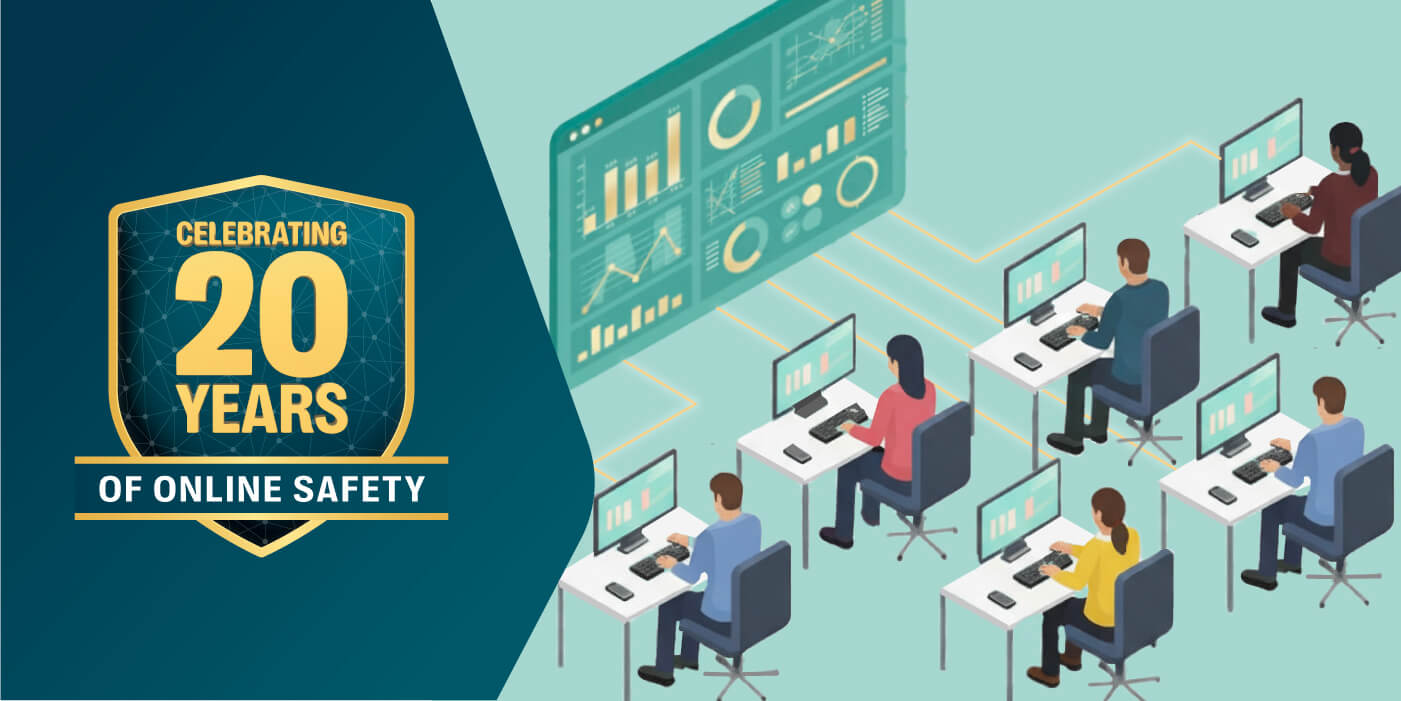This is the sixth installment in our series: “20 Years in Online Safety: Reflecting, Evolving, and Adapting,” leading to the 20th anniversary of Resolver’s presence in the Trust & Safety community on Nov. 25, 2025. Originally launched as Crisp Thinking in 2005, we’ve had multiple generations of online safety professionals carry the mission forward. For this series, we asked our team, managers, and leadership to reflect on the journey we’ve taken so far and the road ahead, as we continue in our core mission to protect children online.
The evolution of online safety isn’t just a story of advancing technology; it’s a story of evolving expertise.
Over 20 years, Resolver has learned that true foresight comes from diverse minds working together — deep-focus specialists who see every detail, and broad-perspective generalists who see the patterns that connect them.
Technology alone doesn’t create foresight; it’s the collaboration between technical specialists and cross-disciplinary thinkers that drives real safety progress.Together, they form a team uniquely built to predict and prevent harm before it happens.
In this reflection, Junyue Jin, Senior Data Scientist, and Louisa Winters, Senior Subject Matter Expert in Online Harassment Risks, show how “wearing many hats” has shaped Resolver’s culture and strengthened our ability to stay ahead of threats.
From filtering to foresight
by Junyue Jin
When I joined Resolver in 2011, I was, what we called, a “Front-Line Shield,” a core specialist role focused on Real-time Managed Filtering (RMF). This was fundamental safeguarding, blocking harmful content, such as extremely offensive language, sexual content, or grooming attempts across live environments in 16 languages.
This work was a continuous, real-time battle of wits. We had to be forensic to counteract the extreme creativity users employed to bypass our filtering systems. That expertise soon became the backbone of Resolver’s partner relationships. We moved from merely blocking terms to managing full safety policies for major platforms.
We soon realized that blocking content alone couldn’t stop harm from spreading. Grooming and exploitation evolved faster than static rules could adapt. This marked a crucial turning point: shifting from defense to proactive investigation, where we began tracing behavior, not just words or content. Identifying grooming attempts, off-platform migration, and early risk signals became the blueprint for the proactive, predictive intelligence we deliver to partners today.
Trail tracing and unfurling the map
We introduced “Trail Tracing,” moving beyond content to behavioral analysis. We developed recipes to flag and label risky digital behaviors based on conduct patterns. I felt a sense of accomplishment when our analytical rules successfully identified sophisticated grooming attempts, including invitations to meet offline or suggestions to move conversations off our partners’ platforms to evade detection.
This shift to behavioral intelligence marked the start of a new mindset: specialist precision fused with analytical curiosity. By combining deep linguistic and cultural expertise with a broader investigative approach, we began uncovering entire networks of risk, not just single offenders.
As our work evolved, Resolver expanded its data science capabilities, which encouraged me to deepen my own learning through courses and collaboration with new team members who brought diverse technical expertise. Together, we developed advanced network analysis methods that allowed us to transform individual case findings into actionable insights about how threat actors organize, communicate, and adapt.
That’s when I realized a single trail wasn’t an endpoint, but a thread. We started asking, “What comes next?” By treating each signal as a “seed” and applying network analysis, we moved from tracing one path to unfurling the entire map of hidden networks. This ability to identify and disrupt interconnected systems — by detecting communities based on their interactions and behavioral trends — proved essential in combating the spread of Child Sexual Abuse Material (CSAM).
It was the moment I understood the power of being more than a specialist: the impact of thinking systematically and connecting insights across disciplines to predict and prevent harm.
Seeing the bigger picture
by Louisa Winters
While specialists were defining and building these sophisticated detection systems, the operational and partner-facing teams were building the crucial breadth needed to put them into action.
When I joined the team in 2018, I was immediately drawn to the collective mission to make online spaces safer. I started as an Analyst, diving deep into online hate speech and harmful behaviors. But the more I worked across different risk areas and functions, the clearer it became: we need more people who understand how every part of the process fits together.
As online harms became more complex, I moved from hands-on risk detection and research to a broader generalist. Each role gave me a new lens on the work — allowing me to see the mission from multiple angles. I gained unique experience working at every stage of delivery within the Human Intelligence team: from researching emerging trends and writing analytical reports, to eventually leading internal training as a Subject Matter Expert in online harassment.
My perspective grew broader when I became a Partner Manager. That experience took me beyond the day-to-day tangible outputs to managing partner relationships, building trust, and overseeing large-scale safety initiatives. Working directly with stakeholders who cared deeply about child safety was a profound reminder of the vital human impact of our technical work.
That variety didn’t dilute my expertise; it deepened it. It taught me to translate between the technical, the operational, and the strategic. Our cross-functional understanding lets us anticipate how harms evolve — and how to build solutions that truly work for the platforms we support.
A culture of connected expertise
Our teams have evolved with the same agility as the risks we monitor. From data scientists and engineers to analysts, policy experts and product leads, each person brings both depth and flexibility.
Our technology has progressed to truly understand users — not just what they say, but how they behave and who they are. We’ve shifted our focus to actor detection, leveraging large-scale data and analyzing behavioral patterns to identify and categorize malicious networks across multiple risk types.
That progress isn’t accidental. It reflects the deliberate design of our adaptive culture. Data scientists evolve into predictive intelligence specialists. Operational analysts grow into strategic subject matter experts. Our success relies on the collaboration between the subject matter experts who can advise on policy and strategy, the data specialists who build the complex systems, and the generalists who can fluidly bridge the technical and partner worlds.
This blend keeps Resolver adaptable and one step ahead. Our strength lies not just in what our people know today, but how quickly they learn, adapt, and connect that knowledge across contexts and disciplines. It’s why we’ve evolved from content detection to predictive, actor-level intelligence — and why we continue to lead in tackling the most complex forms of online harm.
A unified future for online safety teams
As we enter our third decade, one lesson stands out: the future of safety depends on the people who can grasp the details and still see the whole picture.
At Resolver, that’s our greatest advantage — a diverse team of experts, thinkers, and doers who think like data scientists, act like investigators, and communicate like strategists. The next generation of online safety will not be won by technology alone. It will be led by people who know how to use it and never stop learning.
Here’s to continuing the fight against online harms and mentoring the next generation who will discover that wearing many hats is the most powerful and rewarding path to a safer online world.
As we reflect on two decades of protecting children and safeguarding online spaces we’re also looking ahead to the next frontier of Trust & Safety: the proactive, intelligent elimination of CSAM. Resolver’s new Unknown CSAM Detection Service represents the culmination of 20 years of learning, evolving, and purpose. It’s built to identify, prevent, and remove child sexual abuse material at speed and scale, while protecting humans behind the screen.
Learn more about how we’re redefining child safety for the next generation.
More from Trust & Safety’s 20th Anniversary series:
- Two Decades of Protection: Resolver’s Constant Evolution in Online Child Safety
- What We Call Threats: Evolving Taxonomies and the Role of Regulation
- From “Chicken Soup” to Catastrophe: The Dangers of an English-Only Trust & Safety Model
- The Human at the Heart of the Machine: A 20-Year Lesson in Online Safety
- From Reactive to Predictive: Why It’s No Longer Enough to Spot What’s Already Happened


